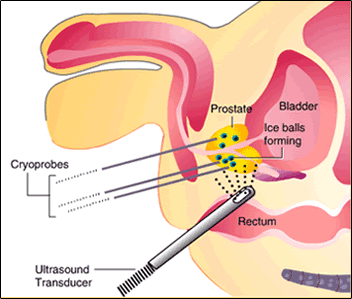
|
|
Cryotherapy TreatmentLocalised Prostate Cancer treatment with CryotherapyCryotherapy is a minimally invasive procedure designed to cure prostate cancer in the early stages. It may also be used for late recurrence of localised prostate cancer after radiotherapy. This procedure is carried out in the Day Surgery. The patient is given a general anaesthetic. A digitally enhanced Ultrasound probe is inserted into A series of very fine hollow needles are then placed through the holes of the template into the prostate Once the needles are in the appropriate place as checked on the ultrasound, Argon and Helium gases are used to freeze the prostate tissue in measured amounts around the needles. Warming of the areas where freezing is not required is simultaneously carried out. Warming probes and temperature probes are passed in between the rectum and the prostate to ensure that the bowel is not frozen. The prostate is cooled to a temperature of -40° C and this creates an “ice ball” which damages the cancer cells to kill them. The warming needles then raise the temperature and the freezing process is then repeated. During the whole procedure the patient’s upper body is kept warm with a special warming blanket and intravenous fluids and antibiotics ensure the patient is well hydrated and there is minimal risk of infection. Following the procedure the patient is woken from the anaesthetic, a dressing pad will be present between the legs behind the scrotum to reduce the risk of bruising and swelling. A catheter will be present in the bladder draining the urine. The patient will remain in bed while the Nurses carry out the routine observations and monitoring following surgery. These include, monitoring of the patient’s temperature, pulse, blood pressure and respiratory rate. When the patient is suitably awake he may start eating and drinking as tolerated. He will remain resting in bed for a period of 2-3 hours. The catheter will stay in place for a few days and an information brochure (Management of Indwelling Catheter © 2006) will be given to the patient with instructions regarding management of the catheter which will also be taught by the Nurses before the patient goes home. He will be able to be discharged from hospital or Day Surgery after having been reviewed and discharge deemed appropriate. Pain ReliefMedication for pain relief will be prescribed as appropriate. Generally speaking medication such as Panadol and Panadeine Forte are sufficient. Driving and going back to work or exerciseThe majority of my patients can drive within a day or two and go back to work in five to seven depending on the occupation. Even though there is a catheter in the bladder the catheter is connected to a leg bag which is placed around the thigh and the urine is collected in the bag, it is possible for you to drive a car or go out to at this time. In terms of going back to work, it depends upon the amount of physical exercise and physical energy that is required at your job. If you have a desk job the majority of the patients can return to work in a few days. If your job requires more physical labour, then it would be recommended that at least two weeks are taken off from work. What kind of follow-up is there?Follow-up after Cryosurgery patients may be admitted to Day Surgery or Cairns Urology so that the catheter can be removed and the bladder volumes monitored by Ultrasound 5 to 7 days after the procedure. They are usually seen at the Consulting Rooms first to check that catheter removal is appropriate at that stage. Once it has been removed the patients are usually seen 3 to 4 weeks later to assess progress. They are seen back again in 2 to 3 months with a PSA and a physical examination. It is recommended that all Cryosurgical patients have a physical examination and PSA every 3-4 months for the first 2 years and then every 6 months thereafter. There is no need for additional biopsies unless the PSA rises and local recurrence is suspected. Read more about: |

 In addition, a special catheter is inserted down the penis with an in-flow channel and an out-flow channel allows warm saline containing water to be pumped down one channel and return through another in a circulating fashion to warm that also so that there is a reduced risk of damage to the urethra (pipe).
In addition, a special catheter is inserted down the penis with an in-flow channel and an out-flow channel allows warm saline containing water to be pumped down one channel and return through another in a circulating fashion to warm that also so that there is a reduced risk of damage to the urethra (pipe).